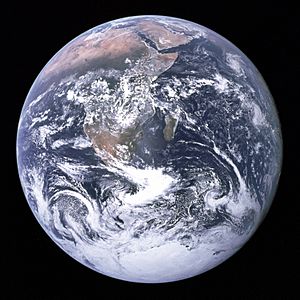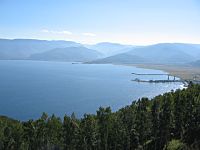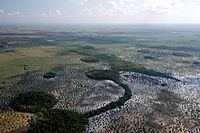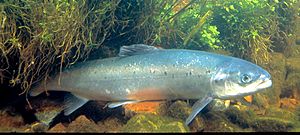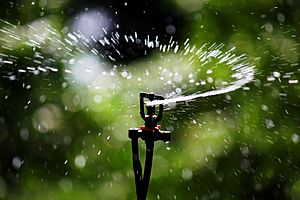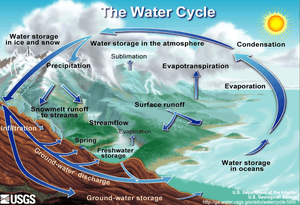Fresh water facts for kids
Fresh water (also 'freshwater' or 'fresh-water') is water that does not have a lot of salt in it.
When people say 'fresh water', they usually mean water from the lakes, rivers, snow, and ice, which is not salty. It also can mean water that people can drink. The oceans and seas are made up of salt water, which people cannot drink.
However, people cannot drink all fresh water, because it might be contaminated. It might have harmful bacteria in it, or poisonous because of chemicals it contains. Water from a tap has been tested and treated so that it is safe to drink. This applies to most countries, but in some place the water needs to be boiled first to kill the germs and drunk after it has cooled down.
Fresh water that people can drink safely is called 'potable water'. Desalination can turn salt water into drinkable water.
Contents
Systems
Fresh water habitats are divided into lentic systems, which are the stillwaters including ponds, lakes, swamps and mires; lotic, or running-water systems; and groundwater which flows in rocks and aquifers. There is, in addition, a zone which bridges between groundwater and lotic systems, which is the hyporheic zone, which underlies many larger rivers and can contain substantially more water than is seen in the open channel. It may also be in direct contact with the underlying underground water. The majority of fresh water on Earth is in ice caps.
The source of almost all fresh water is precipitation from the atmosphere, in the form of mist, rain and snow. Fresh water falling as mist, rain or snow contains materials dissolved from the atmosphere and material from the sea and land over which the rain bearing clouds have traveled. In industrialized areas rain is typically acidic because of dissolved oxides of sulfur and nitrogen formed from burning of fossil fuels in cars, factories, trains and aircraft and from the atmospheric emissions of industry. In some cases this acid rain results in pollution of lakes and rivers.
In coastal areas fresh water may contain significant concentrations of salts derived from the sea if windy conditions have lifted drops of seawater into the rain-bearing clouds. This can give rise to elevated concentrations of sodium, chloride, magnesium and sulfate as well as many other compounds in smaller concentrations.
In desert areas, or areas with impoverished or dusty soils, rain-bearing winds can pick up sand and dust and this can be deposited elsewhere in precipitation and causing the freshwater flow to be measurably contaminated both by insoluble solids but also by the soluble components of those soils. Significant quantities of iron may be transported in this way including the well-documented transfer of iron-rich rainfall falling in Brazil derived from sand-storms in the Sahara in north Africa.
Water distribution
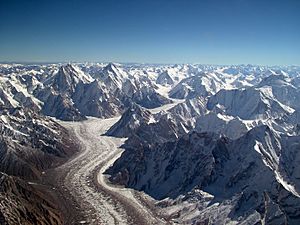
Water is a critical issue for the survival of all living organisms. Some can use salt water but many organisms including the great majority of higher plants and most mammals must have access to fresh water to live. Some terrestrial mammals, especially desert rodents appear to survive without drinking but they do generate water through the metabolism of cereal seeds and they also have mechanisms to conserve water to the maximum degree.
Out of all the water on Earth, saline water in oceans, seas and saline groundwater make up about 97% of it. Only 2.5–2.75% is fresh water, including 1.75–2% frozen in glaciers, ice and snow, 0.5–0.75% as fresh groundwater and soil moisture, and less than 0.01% of it as surface water in lakes, swamps and rivers. Freshwater lakes contain about 87% of this fresh surface water, including 29% in the African Great Lakes, 22% in Lake Baikal in Russia, 21% in the North American Great Lakes, and 14% in other lakes. Swamps have most of the balance with only a small amount in rivers, most notably the Amazon River. The atmosphere contains 0.04% water. In areas with no fresh water on the ground surface, fresh water derived from precipitation may, because of its lower density, overlie saline ground water in lenses or layers. Most of the world's fresh water is frozen in ice sheets. Many areas suffer from lack of distribution of fresh water, such as deserts.
Aquatic organisms
Fresh water creates a hypotonic environment for aquatic organisms. This is problematic for some organisms with pervious skins or with gill membranes, whose cell membranes may burst if excess water is not excreted. Some protists accomplish this using contractile vacuoles, while freshwater fish excrete excess water via the kidney. Although most aquatic organisms have a limited ability to regulate their osmotic balance and therefore can only live within a narrow range of salinity, diadromous fish have the ability to migrate between fresh water and saline water bodies. During these migrations they undergo changes to adapt to the surroundings of the changed salinities; these processes are hormonally controlled. The eel (Anguilla anguilla) uses the hormone prolactin, while in salmon (Salmo salar) the hormone cortisol plays a key role during this process.
Many sea birds have special glands at the base of the bill through which excess salt is excreted. Similarly the marine iguanas on the Galápagos Islands excrete excess salt through a nasal gland and they sneeze out a very salty excretion.
Fresh water as a resource
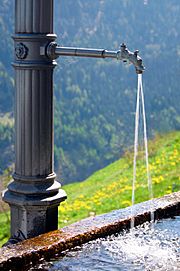
An important concern for hydrological ecosystems is securing minimum streamflow, especially preserving and restoring instream water allocations. Fresh water is an important natural resource necessary for the survival of all ecosystems. The use of water by humans for activities such as irrigation and industrial applications can have adverse impacts on down-stream ecosystems. Chemical contamination of fresh water can also seriously damage eco-systems.
Pollution from human activity, including oil spills and also presents a problem for freshwater resources. The largest petroleum spill that has ever occurred in fresh water was caused by a Royal Dutch Shell tank ship in Magdalena, Argentina, on 15 January 1999, polluting the environment, drinkable water, plants and animals.
Fresh and unpolluted water accounts for 0.003% of total water available globally.
Agriculture
Changing landscape for the use of agriculture has a great effect on the flow of fresh water. Changes in landscape by the removal of trees and soils changes the flow of fresh water in the local environment and also affects the cycle of fresh water. As a result, more fresh water is stored in the soil which benefits agriculture. However, since agriculture is the human activity that consumes the most fresh water, this can put a severe strain on local freshwater resources resulting in the destruction of local ecosystems. In Australia, over-abstraction of fresh water for intensive irrigation activities has caused 33% of the land area to be at risk of salination.
Limited resource
Fresh water is a renewable and variable, but finite natural resource. Fresh water can only be replenished through the process of the water cycle, in which water from seas, lakes, forests, land, rivers, and reservoirs evaporates, forms clouds, and returns as precipitation. Locally however, if more fresh water is consumed through human activities than is naturally restored, this may result in reduced fresh water availability from surface and underground sources and can cause serious damage to surrounding and associated environments.
Fresh water withdrawal
Fresh water withdrawal is the quantity of water removed from available sources for use in any purpose, excluding evaporation losses. Water drawn off is not necessarily entirely consumed and some portion may be returned for further use downstream.
Causes of limited fresh water
The increase in the world population and the increase in per capita water use puts increasing strains on the finite resources avialability of clean fresh water. The World Bank adds that the response by freshwater ecosystems to a changing climate can be described in terms of three interrelated components: water quality, water quantity or volume, and water timing. A change in one often leads to shifts in the others as well. Water pollution and subsequent eutrophication also reduces the availability of fresh water.
Fresh water in the future
Many areas of the world are already experiencing stress on water availability. Due to the accelerated pace of population growth and an increase in the amount of water a single person uses, it is expected that this situation will continue to get worse. A shortage of water in the future would be detrimental to the human population as it would affect everything from sanitation, to overall health and the production of grain.
Related pages
See also
 In Spanish: Agua dulce para niños
In Spanish: Agua dulce para niños


